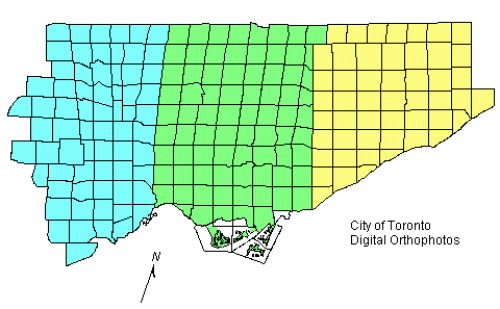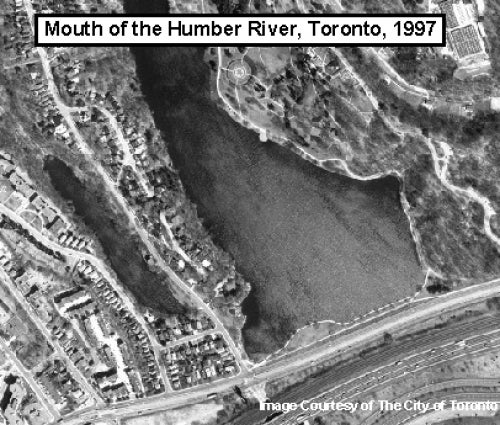Contact the Geospatial Centre
Dana Porter Library, Room 328
University of Waterloo Library
Waterloo, Ontario N2L 3G1
Email: librarygeo@uwaterloo.ca
This set of digital orthoimages provides coverage of the City of Toronto (post-amalgamation). These images were flown in 1997 and then provided to the Geospatial Centre by the City of Toronto, Survey and Mapping Services in 2003. Pixel resolution of these geotiff images is 50 cm.
This map illustrates how the index for Toronto is divided into three areas: west, central, and east. Click on the area of interest to display a detailed index map showing the individual image numbers.

These images are available in Modified Transverse Mercator (MTM) zone 10, North American Datum (NAD) 27 co-ordinate system. The images are available in compressed MrSID format. Other data formats can be accommodated, as the Geospatial Centre has access to a number of conversion utilities.
To request this data, please fill out the Ask-Us form and include which layers (shapefiles) you are interested in obtaining. The dataset will be shared with you via OneDrive upon completion of the data release agreement form. You may also make an in-person appointment using the same form.
This material is provided for academic, research, teaching, and personal use only. A data release agreement must be agreed to before the data is delivered. The City of Toronto Geospatial Competency Centre should be acknowledged on any derivative product, such as a map or an image.
City of Toronto digital orthophotos [computer file]. Toronto, Ontario: City of Toronto, Geospatial Competency Centre [1997].

Dana Porter Library, Room 328
University of Waterloo Library
Waterloo, Ontario N2L 3G1
Email: librarygeo@uwaterloo.ca
The University of Waterloo acknowledges that much of our work takes place on the traditional territory of the Neutral, Anishinaabeg, and Haudenosaunee peoples. Our main campus is situated on the Haldimand Tract, the land granted to the Six Nations that includes six miles on each side of the Grand River. Our active work toward reconciliation takes place across our campuses through research, learning, teaching, and community building, and is co-ordinated within the Office of Indigenous Relations.